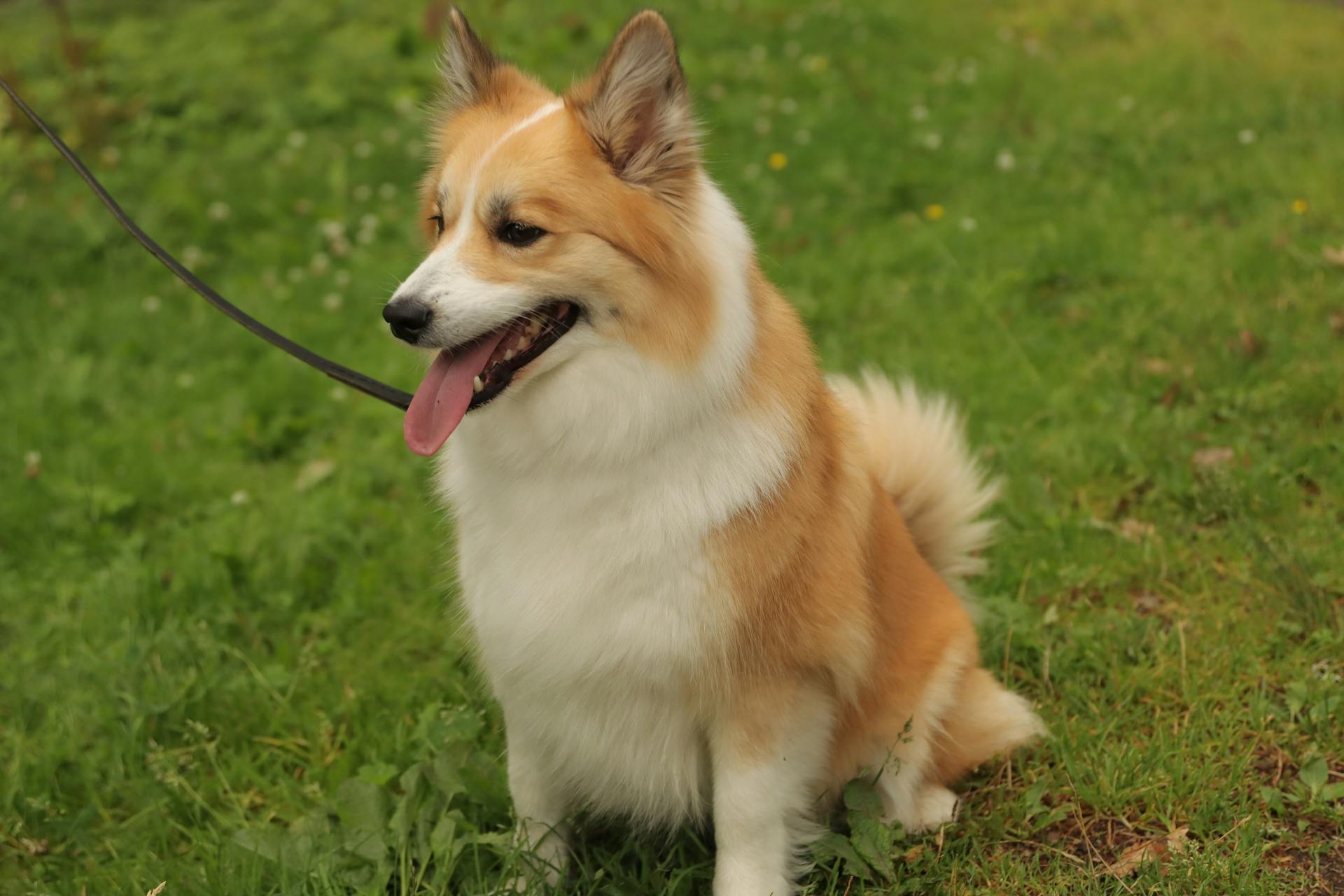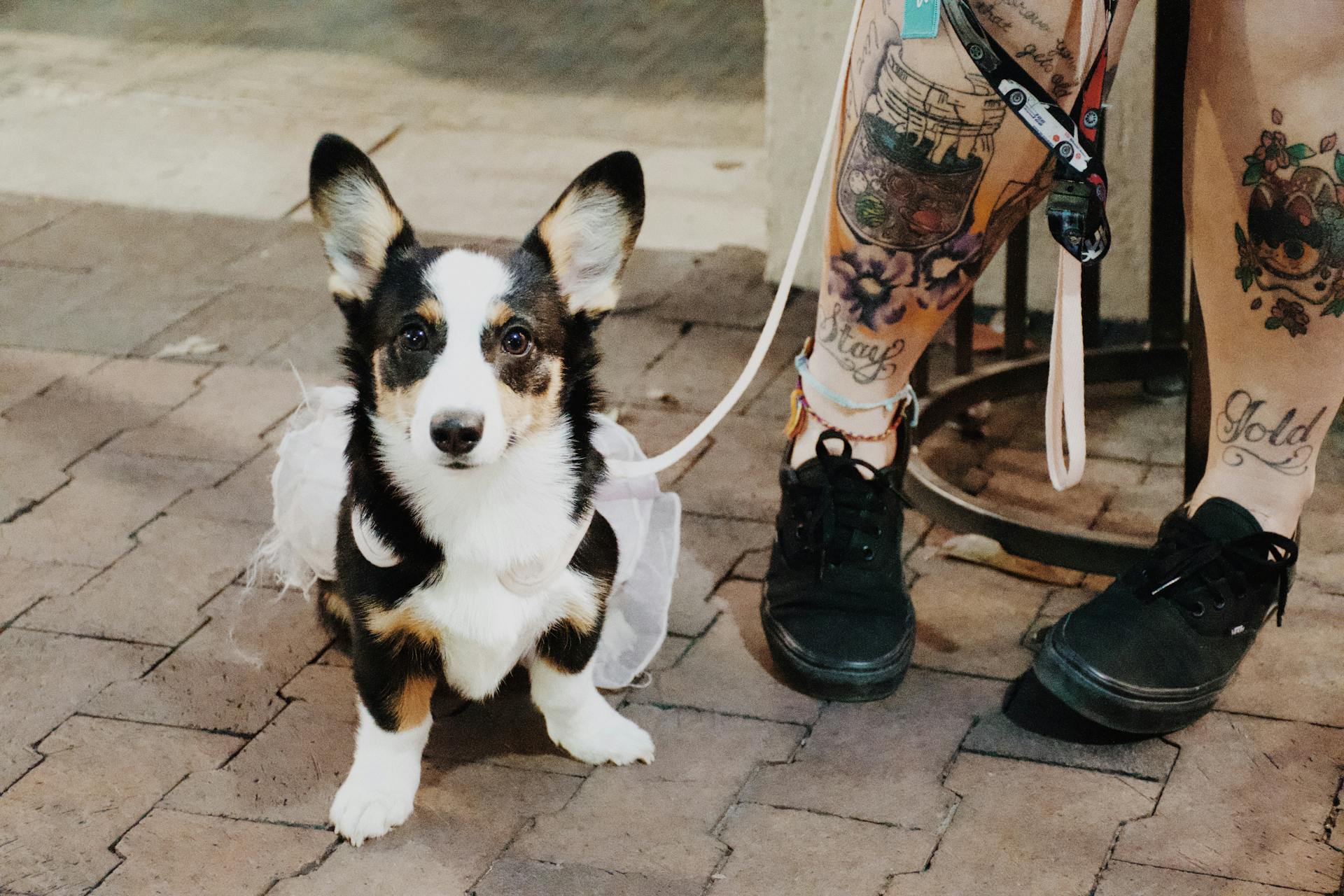
IVDD, or Intervertebral Disc Disease, is a common health issue in Corgis.
Corgis are prone to IVDD due to their unique body structure, which can put extra pressure on their spine.
Their short stature and long bodies create an uneven weight distribution, putting stress on their discs.
This can lead to herniated or bulging discs, which can cause severe pain and even paralysis.
IVDD can affect any Corgi, but certain breeds within the Pembroke Welsh Corgi family are more susceptible due to genetic factors.
What is IVDD?
IVDD, or Intervertebral Disc Disease, is a common health issue in dogs.
It's caused by a herniated or ruptured disc in the spine, which can put pressure on the surrounding nerves and cause pain, weakness, or paralysis in the affected area.
IVDD can be classified into two main types: acute and chronic. Acute IVDD occurs suddenly, often due to a traumatic injury, while chronic IVDD develops gradually over time due to wear and tear on the discs.
Chronic IVDD is more common in older dogs, especially those with a history of back problems or obesity.
The symptoms of IVDD can vary depending on the severity and location of the disc damage, but common signs include pain, stiffness, and difficulty walking or standing.
In severe cases, IVDD can cause permanent paralysis or incontinence, so prompt veterinary attention is essential if you suspect your dog is showing any of these symptoms.
A fresh viewpoint: Most Common Dog Diseases
Symptoms and Signs
Corgis with IVDD may display a range of symptoms, from mild to severe.
Head held low is a common symptom of cervical IVDD, where the disc in the neck is affected.
Arching back is another possible sign, which can range from mild to severe.
Shivering or crying can be an indication of pain or discomfort in the neck or back region.
Reluctance to move, especially in ways that involve the spine, is a common symptom of IVDD.
See what others are reading: Golf Ball Sized Lump on Dog
Inability to walk normally or support own weight can be a sign of severe IVDD.
Knuckling of all 4 paws or dragging rear legs can occur in dogs with thoracolumbar IVDD.
Muscle spasms and tense belly can be symptoms of thoracolumbar IVDD.
Weakness in hind legs or crossing back legs when walking can be signs of thoracolumbar IVDD.
Pain and/or difficulty jumping can be symptoms of lumbosacral IVDD.
Limp tail can be a sign of lumbosacral IVDD.
Back pain, ranging from mild to severe, can be a symptom of IVDD.
Dogs with IVDD may exhibit signs of discomfort or pain, such as arching their back or flinching when touched.
Reluctance to move or engage in physical activity can be a sign of IVDD.
Stiffness or awkward gait can be symptoms of IVDD.
Weakness or lethargy in the limbs can occur in dogs with IVDD.
Loss of coordination, particularly in the hind end, can be a sign of IVDD.
Loss of bladder or bowel control can occur in severe cases of IVDD.
Paralysis can occur in the most severe cases of IVDD.
Behavioral changes, such as irritability or withdrawal, can be signs of IVDD.
Here are some common symptoms of IVDD in dogs:
- Back pain
- Reluctance to move
- Stiffness or awkward gait
- Weakness or lethargy
- Loss of coordination
- Loss of bladder or bowel control
- Paralysis
- Behavioral changes
Diagnosis and Treatment
Diagnosing IVDD in Corgis requires immediate veterinary care if symptoms appear. Tests typically include standard x-rays, a neurological exam, and/or MRI to locate the disc or discs causing symptoms.
If your Corgi is diagnosed with a mild to moderate IVDD injury, treatment may include steroid and anti-inflammatory medications to reduce pain and swelling, combined with strict crate-rest for approximately 4-6 weeks.
In less severe cases, some dogs may benefit from anti-inflammatory medication to reduce swelling in the spinal cord, which can reduce pain and allow the spinal cord to begin healing.
Non-surgical treatment options for IVDD may include strict rest, medication, physical therapy, supportive measures, and close monitoring. The effectiveness of non-surgical treatment depends on factors such as the severity and location of the affected discs, as well as the individual dog's response to treatment.
Here are some non-surgical treatment options for IVDD in Corgis:
- Strict Rest: Restricting the dog's activity to minimize further stress on the spine.
- Medication: Pain management and anti-inflammatory medications prescribed by a veterinarian.
- Physical Therapy: Exercises to improve mobility and strengthen supporting muscles.
- Supportive Measures: Using a dog back brace or other assistive devices to provide additional stability to the spine.
- Close Monitoring: Regular check-ups with a veterinarian to track progress and make adjustments to the treatment plan.
Surgery is typically recommended for dogs suffering from more severe cases of IVDD where rest and medication are not sufficient to reduce pain and other symptoms.
How Is Diagnosed?

If your dog starts showing symptoms of IVDD, it's essential to seek immediate veterinary care. A thorough neurological exam is usually the first step in diagnosing the condition.
Standard x-rays and MRI tests can help locate the disc or discs causing your dog's symptoms. A myelogram may also be conducted to visualize the disc and spinal cord.
Other disease processes can share symptoms with IVDD, including fractures, vertebral tumors, or infections. Your veterinarian will need to rule out these factors before making a diagnosis.
A CT scan or MRI may be needed if surgery is required, as a surgeon needs precise imaging to conduct the best surgical treatment.
Treatment of
Treatment of IVDD can be a bit of a puzzle, but don't worry, there are several options to consider.
For less severe cases, anti-inflammatory medications can help reduce pain and swelling, combined with strictly reduced activity for approximately 4-6 weeks. This can be a crucial step in allowing the body to heal naturally.
Medication, such as pain management and anti-inflammatory medications, can help alleviate discomfort and reduce inflammation. Your veterinarian will prescribe the best course of treatment for your dog.
Back Bracing and Canine Rehab (Canine Physical Therapy) can also be very helpful in supporting your dog's recovery. These treatments can improve mobility and strengthen supporting muscles.
If your dog's condition is more severe, surgery may be necessary to remove the hardened disc material that's pressing on the spinal cord. In some cases, surgery can be a game-changer for your dog's quality of life.
Here are some non-surgical treatment options for IVDD:
- Strict Rest: Restricting the dog's activity to minimize further stress on the spine.
- Medication: Pain management and anti-inflammatory medications prescribed by a veterinarian.
- Physical Therapy: Exercises to improve mobility and strengthen supporting muscles.
- Supportive Measures: Using a dog back brace or other assistive devices.
- Close Monitoring: Regular check-ups with a veterinarian.
Remember, every dog is different, and the effectiveness of non-surgical treatment depends on factors such as the severity and location of the affected discs, as well as the individual dog's response to treatment.
A different take: Ivdd in Dachshunds Treatment
Recovery and Life Expectancy
A Corgi's life expectancy with IVDD largely depends on the severity of the condition, their age, and overall health.
While some Corgis may experience occasional flare-ups, proper treatment and management can help them live happy and active lives.
Mild cases of IVDD can be well-controlled with medication and rest, and many dogs can thrive despite the condition.
Prompt and effective treatment, including surgery and rehabilitation, can lead to remarkable recoveries, especially in more severe cases.
Regular veterinary check-ups and following recommended treatment plans are key to ensuring the best possible outcome for a Corgi with IVDD.
With the right care, many Corgis can recover from IVDD and enjoy a good quality of life for years to come.
Can a Recover?
Can a dog recover from IVDD?
Dogs can recover from IVDD, but the extent of recovery depends on various factors, including the severity of the condition, the location of the affected disc, and how quickly it is diagnosed and treated.
The prognosis largely depends on the severity of the condition, the location of affected discs, the dog's age, and overall health. Regular veterinary check-ups and following recommended treatment plans are key in ensuring the best possible outcome for a dog with degenerative disc disease.

Mild cases of IVDD may respond well to conservative treatments, such as strict rest, anti-inflammatory medication, and physical therapy. With these measures, many dogs can experience significant improvement and return to a good quality of life.
Surgery can provide the best chance for recovery in more severe cases, especially those involving paralysis. The use of a dog back brace or other supportive devices may be recommended to aid in the recovery process.
Recovery from IVDD is a gradual process, and patience is key. Close monitoring by a veterinarian is essential, and they will provide guidance on the best course of action for your specific situation.
Readers also liked: Best Homemade Food for Corgis
New Stride
A new stride is a common sign that your dog is recovering from IVDD. This could be a slight change in their gait, where they drag one or both limbs.
You might notice your dog's reluctance to jump on or off furniture, or lower their head to a food bowl to eat. This is because they're experiencing pain or discomfort in their back region.

Some dogs may even develop a loss of bladder control due to the pressure on their spinal cord. It's essential to keep a close eye on your dog's behavior and consult with a veterinarian if you notice any of these symptoms.
A new stride can be a sign of recovery, but it's also a reminder that your dog needs ongoing care and support. With the right treatment and care, many dogs can learn to adapt to their new stride and live a happy, healthy life.
Here are some common symptoms of a new stride:
- Dragging one or both limbs
- Reluctance to jump on or off furniture
- Difficulty lowering their head to a food bowl
- Loss of bladder control
In some cases, a new stride may be accompanied by muscle spasms, tense belly, or weakness in the hind legs. If you notice any of these symptoms, it's essential to consult with a veterinarian to determine the best course of action.
Risk Factors and Prevention
Corgis are prone to Intervertebral Disc Disease (IVDD), which can be a serious condition.
Regular veterinary check-ups are crucial to monitor your corgi's health and catch any potential issues early on.
IVDD can occur in any breed or mixed-breed dog, including corgis, but certain characteristics like long bodies and short legs increase the risk.
Corgis, with their elongated bodies, are at a higher risk for IVDD due to their unique body shape.
Individual factors like genetics, age, weight, and overall health can also influence a dog's risk for developing IVDD.
Some breeds commonly predisposed to IVDD include Dachshunds, Basset Hounds, and French Bulldogs, all of which have similar body types to corgis.
What Causes?
IVDD is an age-related, gradual degenerative process that affects the spinal cord of the dog over a period of time, often undetected.
Even with yearly wellness exams, your vet may not detect any signs of IVDD until your dog's hardened disc or discs become ruptured and painful symptoms become evident.
A jump up onto the sofa could damage a disc that has been weakened by IVDD, and trigger acute and painful symptoms of the disease.

The hardened discs between your dog's vertebrae will typically go on to bulge and compress the spinal cord, often damaging the dog's nerve impulses such as those that control bladder and bowel control.
A simple jump or poor landing can lead one or more of the hardened discs to burst and press into the nerves of the dog's spinal cord, causing pain, possible nerve damage or even paralysis.
At Risk
Dogs that are prone to IVDD often share certain physical characteristics, such as long bodies and short legs. This is particularly true for breeds like Dachshunds, Basset Hounds, and Corgis.
Some breeds are more susceptible to IVDD due to their unique body shape. For example, French Bulldogs have a relatively long body, while Pekingese have a flat face and long back.
Individual factors like genetics, age, weight, and overall health can also influence a dog's risk for developing IVDD. Regular veterinary check-ups and preventive measures can help manage this risk.
If this caught your attention, see: What Breeds of Dogs Are Prone to Deafness
Certain breeds are more prone to IVDD due to selective breeding. For instance, Dachshunds and Corgis have been bred to have a low-slung stature, which affects cartilage growth and increases their risk for disc calcification.
Here are some breeds that are commonly predisposed to IVDD:
- Dachshunds: Known for their long body and short legs.
- Basset Hounds: Have a long body and relatively short legs.
- Corgis: Both Pembroke and Cardigan Welsh Corgis have elongated bodies.
- French Bulldogs: Have a relatively long body and can be prone to spinal issues.
- Pekingese: Have a unique body shape with a flat face and long back.
- Beagles: Especially those with a longer body type, can be at a higher risk for IVDD.
- Cavalier King Charles Spaniels: Can be prone to IVDD due to their longer back and sometimes flat skull shape.
It's essential to remember that while these breeds may have a higher predisposition, IVDD can occur in any breed or mixed-breed dog.
You might enjoy: Boxer Breed Problems
Lifting Techniques
Get assistance if possible, as having someone help you ensures the weight is evenly distributed and minimizes the risk of injury to both you and the dog.
Use a supportive sling or towel under the dog's abdomen, making sure it's long enough to provide support along their body.
Stand facing the dog with your feet shoulder-width apart for stability.
Gently lift the dog, keeping their body as level as possible, and avoid twisting your body while lifting to prevent any strain.
If the dog's hind legs are affected, provide extra support for their back end by lifting slightly higher to ensure their hind legs are off the ground.
Consider reading: Foul Odor from Dog
Move slowly and calmly, taking your time and moving at the dog's pace, and avoid sudden movements or jerks.
To safely lift a dog with IVDD, consider the following steps:
- Get assistance if possible
- Use a supportive sling or towel
- Stand facing the dog with feet shoulder-width apart
- Gently lift, keeping the dog's body level
- Avoid twisting and provide extra support for the back end if necessary
Sources
- https://wiggleless.com/pages/ivdd-in-dogs-faq
- https://wiggleless.com/pages/intervertebral-disc-disease-ivdd-in-dogs-slipped-disc
- https://corgi-l.org/dm-and-ivdd-in-corgis/
- https://www.matthews.carolinavet.com/site/pet-health-blog/2020/08/14/ivdd-intervertebral-disc-disease-in-dogs
- https://www.aspcapetinsurance.com/resources/ivdd-in-dogs/
Featured Images: pexels.com


